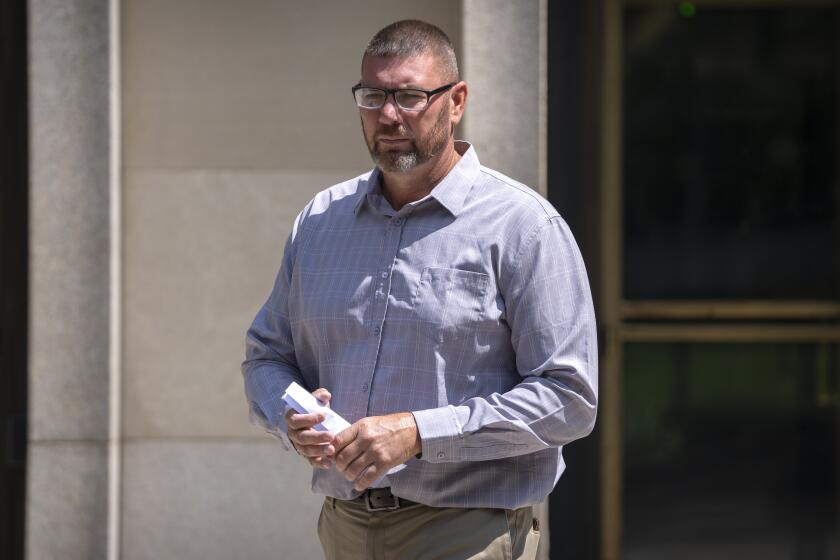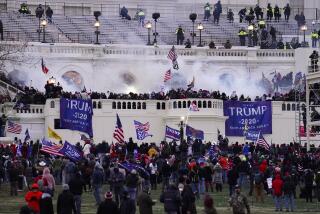Court-martialed military veteran sentenced to more than 4 years in prison for Capitol riot attack

WASHINGTON — A former U.S. Army soldier who was court-martialed for fatally shooting a handcuffed civilian in Iraq two decades ago was sentenced Monday to more than four years in prison for his role in the attack on the U.S. Capitol on Jan. 6, 2021.
Edward Richmond Jr. attacked police officers with a metal baton during the Jan. 6, 2021, riot at the Capitol. Richmond, 41, of Geismar, La., said he immediately regretted his actions that day.
“It was wrong. It was foolish. It was not thought-out. It was spur of the moment,” Richmond said before U.S. District Judge John Bates sentenced him to four years and three months behind bars.
The judge said Richmond appeared to be genuinely remorseful for joining one of the most violent episodes of the Capitol riot — a clash between rioters and outnumbered officers inside a tunnel entrance.
A man who smashed glass door panels at the U.S. Capitol moments before a police officer shot and killed another rioter gets eight years in prison.
“Your conduct was pretty terrible. You’ve recognized that,” Bates said.
More than 1,500 people have been charged with federal crimes stemming from the Capitol riot. More than 650 of them have been sentenced to terms of imprisonment ranging from a few days to 22 years.
Several Jan. 6 riot defendants have asked judges to pause their cases until after President-elect Donald Trump takes office, citing his campaign vow to pardon supporters who stormed the Capitol after his “Stop the Steal” rally near the White House on Jan. 6. Judges have largely rejected those requests and forged ahead with plea hearings and sentencings as scheduled.
Richmond didn’t ask for his sentencing to be delayed. His lawyer, John McLindon, said after the hearing that such a request seemed like a “waste of time.”
A police officer who tried to subdue Michael Sparks of Kentucky with pepper spray described him as a catalyst for the Jan. 6 insurrection.
Prosecutors recommended a prison sentence of five years and three months for Richmond, who will get credit for roughly nine months that he already has served in jail since his arrest.
Richmond was wearing a helmet, goggles and other military-style tactical gear when he attended then-President Trump’s “Stop the Steal” rally near the White House on Jan. 6. After marching to the Capitol, he joined other rioters in a “heave ho” push against police officers guarding a tunnel entrance.
Richmond carried a police shield into the crowd and then returned to the mouth of the tunnel, where he attacked officers with a retractable metal baton, hitting their shields.
Before leaving, Richmond passed along a wooden board for rioters to use against police as a makeshift weapon. He also carried out office furniture from a broken window.
“He pumped it up in the air several times over his head and shouted, drawing huge cheers from the crowd and spurring the rioters on in their violent attack against police,” a prosecutor wrote.
Some of the Donald Trump supporters who stormed the U.S. Capitol on Jan. 6, 2021, are celebrating his 2024 win. ‘Y’all are in trouble,’ one writes.
Richmond was arrested in January and pleaded guilty to an assault charge in August.
Richmond was 20 when an Army court-martial panel convicted him of voluntary manslaughter and sentenced him to three years of military confinement for killing a handcuffed Iraqi civilian near Taal Al Jai in February 2004. Richmond was incarcerated at Fort Sill in Oklahoma and also received a dishonorable discharge from the Army.
The Army said Richmond used a rifle to fatally shoot Muhamad Husain Kadir, a cow herder, in the back of the head from about six feet away after the man stumbled. During Monday’s sentencing, Richmond told the judge that a superior officer had told him to shoot the man if he moved again.
“It was a mistake,” Richmond said. “It was a mistake by a young soldier.”
Kunzelman writes for the Associated Press.
More to Read
Sign up for Essential California
The most important California stories and recommendations in your inbox every morning.
You may occasionally receive promotional content from the Los Angeles Times.













